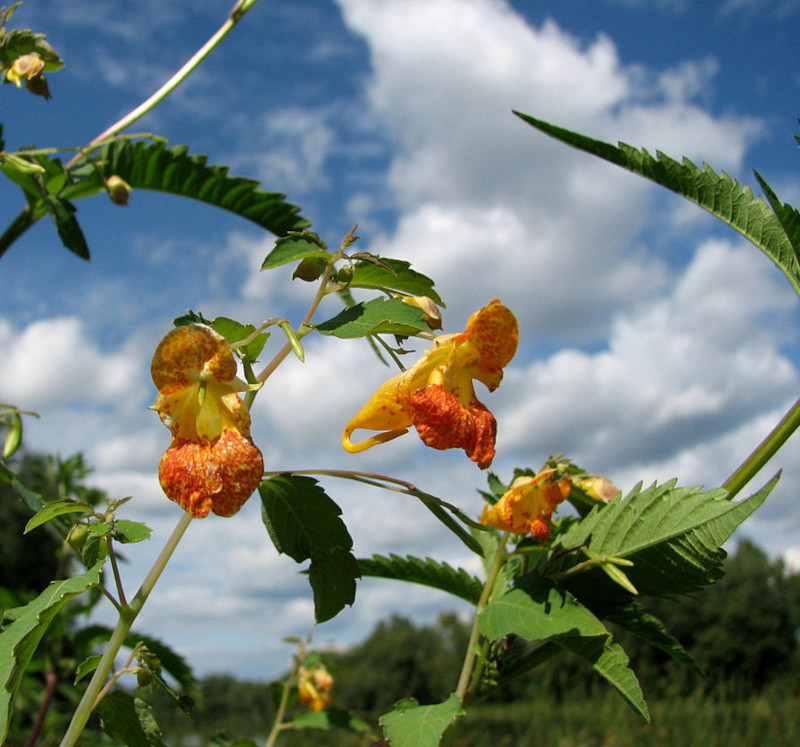
Orange Jewelweed Facts
- This dazzling flora most frequently goes by the descriptive common name of the Orange Jewelweed. The plant has several other alternate titles, as well, though. These include the terms orange balsam, common jewelweed, and the spotted touch-me-not.
- Within scientific circles, however, the Angiosperm is likely better known by its official title. Fortunately for the layperson, that’s a relatively simple one to pronounce. That’s because this marvel of Nature holds the technical moniker of Impatiens capensis.
- The beautiful plant received that simple name due to the efforts of the respected Dutch botanist, Nicolaas Meerburgh. He accomplished the first official recognition of it as a separate and distinct species. That scientifically noteworthy action occurred in 1775.
- Pleasantly, the Orange Jewelweed seems to be maintaining a population base that’s both sufficient and stable. That fortunate situation also appears to hold true throughout the entirety of its territory. The IUCN thus currently lists it as Least Concern.
- Nevertheless, the beautiful creation of Nature faces some potential threats to its continued existence, at least. Like many species, most of these stem from the actions of humans. They include the perils of habitat loss and the effects of climate change.
Related Articles
Orange Jewelweed Physical Description
The Orange Jewelweed captures the attention of those fortunate enough to encounter it. Unlike some herbaceous plants, though, it does so for several reasons. That’s due to the fact that it’s not only lovely to behold, but also attains a respectabe size for its kind.
Individual specimens do vary significantly in growth, largely due to local environmental conditions. As a general principle, however, the species ranges from 3 – 5 ft (0.9 – 1.5 m) in height. A few specimens exceed this, of course, but rarely do so by any great amount.
The wonder of evolution produces thin, yet sturdy vertical stems, typically with a distinctive semi-translucent appearance. These also produce multiple smaller branches. Each of these portions of the plant additionally generally maintain a smooth texture to their surface.
Each example of the impressive Eudicot further produces numerous leaves. This interesting foliage reaches a length equaling as much as 5 in (13 cm) long and 2.5 in (6 cm) in width. Every leaf also possesses sharply serrated edges, and manifests a deep green shade.
Yet it’s the gorgeous blooms of the Orange Jewelweed that most commonly attract the most attention. These generally present a brilliant orange hue. Some do, however, occasionally show a blood-orange shade, and even more rarely, a plae yellow color appears.
Its color serves as the source of the principal common name. However, one of its alternates also stems from a trait of the plant, and a remarkable one at that. When touched, the leaves of the plant often close comparatively quickly in response, thus the name touch-me-not.
- Kingdom: Plantae
- Phylum: Tracheophytes
- Class: Eudicots
- Order: Ericales
- Family: Balsaminaceae
- Genus: Impatiens
- Species: I. capensis
Orange Jewelweed Distribution, Habitat, and Ecology
The visually appealing Orange Jewelweed developed as native to a relatively wide expanse of the globe. Within that natural range, it fits perfectly with the bountiful other botanical wonders. That’s because the marvel evolved as endemic to the continent of North America.
There, it inhabits virtually all of the eastern portions of the country of Canada. Southward, it also appears throughout most of the Northeastern and southern sections of the United States. That range extends as far south as Georgia, and as far west as the state of Oklahoma.
This elegantly beautiful flora also evolved intriguing preferences in its choice of habitat. It primarily inhabits regions of shaded wetlands. Yet the beautiful Angiosperm additionally demonstrates relatively moderate adaptability in this specific regard when needed.
Due to that flexibility, it frequently appears in locations many might consider unlikely. These include such areas as ditches, along creeks, and in regions of bottomland. It also often lives in marshes, bogs, as well as in the forested edges of these same surprising ecosystems.
The awesome Orange Jewelweed developed as a herbaceous annual. Blooming usually occurs between late spring and early fall. Pollination mainly takes place due to the actions of various local varieties of hummingbirds. Certain bees, especially bumblebees, also assist.
Historically, certain parts of the flora also have their uses among humans. Certain Native American herbal remedies used the juice of the leaves and stems. The young shoots can also be consumed as a leafy green vegetable, after boiling. Its seeds are also edible for humans.
Species Sharing Its Range
Check out our other articles on 3 Tantalizing Marvels of Tanzania, Eastern Gray Squirrel, Deception Island, Blue Orchard Bee, Scalloped Hammerhead, Rosy Veincap, Philippine sailfin lizard
